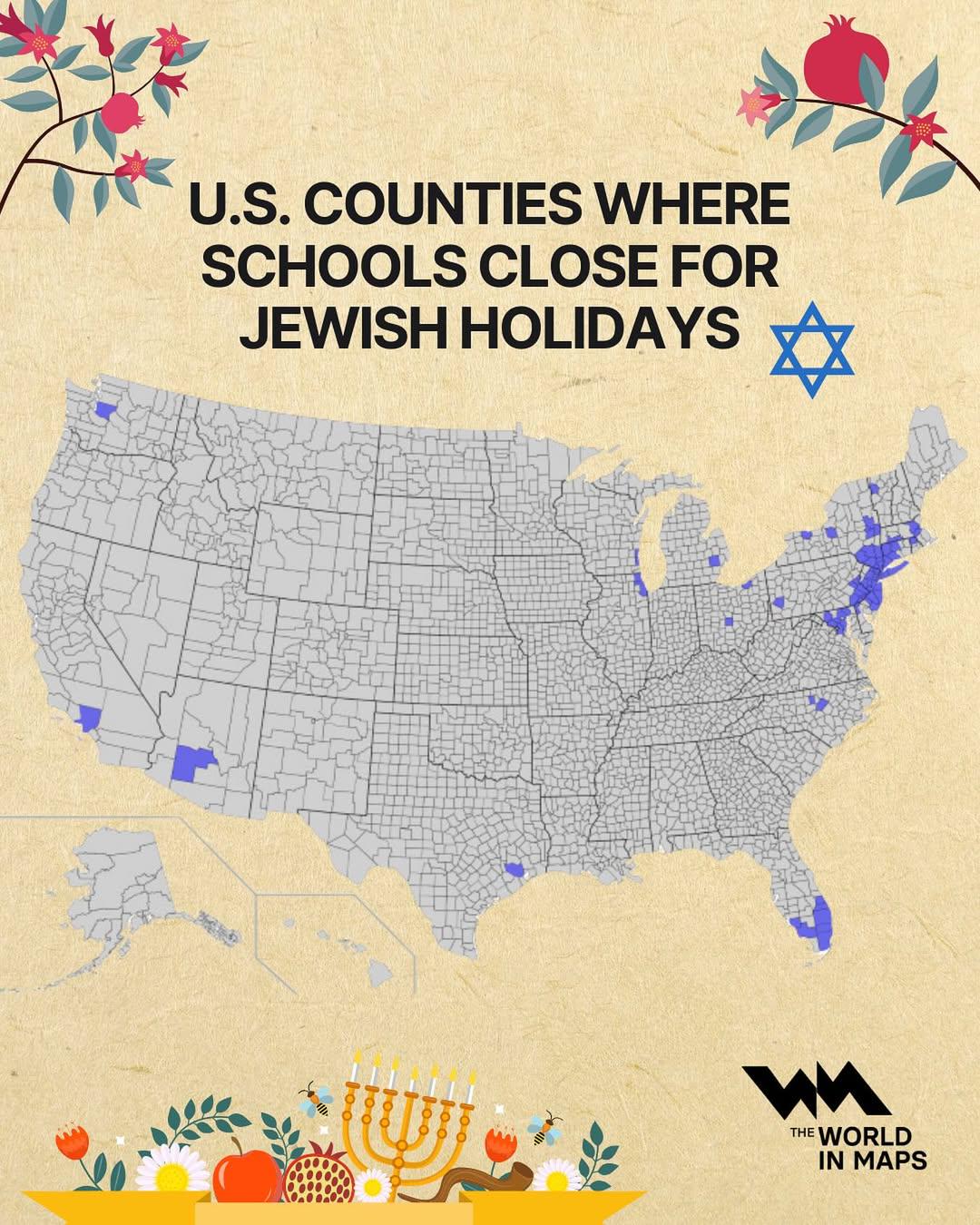Map of U.S. Counties Closing Schools for Jewish Holidays


Alex Cartwright
Senior Cartographer & GIS Specialist
Alex Cartwright is a renowned cartographer and geographic information systems specialist with over 15 years of experience in spatial analysis and data...
Geographic Analysis
What This Map Shows
This map illustrates the U.S. counties where public schools close in observance of Jewish holidays. It provides a visual representation of geographic areas that recognize significant days in the Jewish calendar, such as Rosh Hashanah, Yom Kippur, and Passover. The closures demonstrate the integration of cultural observances into the public education system and highlight the presence of Jewish communities within these regions.
Deep Dive into Jewish Holiday Observances in Education
Jewish holidays are rooted in tradition, spirituality, and community, and they play a significant role in the lives of many Jewish families across the United States. The decision to close public schools on these holidays is often driven by community needs and the recognition of the cultural significance of these days. Notably, Rosh Hashanah, which marks the Jewish New Year, and Yom Kippur, the Day of Atonement, are observed widely among Jewish communities, leading many school districts to accommodate students and families by canceling classes.
Interestingly, the extent of school closures varies significantly across the country. In areas with large Jewish populations, such as New York, New Jersey, and parts of California, you’ll find a higher concentration of school districts that recognize these holidays. According to the Pew Research Center, approximately 2.4% of the U.S. population identifies as Jewish, with a significant presence in urban areas. This demographic reality influences local educational policies, as school boards strive to reflect the cultural diversity of their student bodies.
Have you ever wondered why certain regions are more likely to observe these closures? One reason is the density of Jewish communities. For example, in New York City, where the Jewish population is notably high, public schools commonly close for multiple Jewish holidays. In contrast, rural areas with fewer Jewish residents may not recognize these holidays in their academic calendars, leading to disparities in school operations.
As we dive deeper, it’s essential to consider how these closures affect not only students but also the educational system as a whole. For instance, the decision to close schools can lead to a ripple effect on scheduling and resource allocation. Teachers may have to adjust lesson plans to accommodate these holidays, and parents need to make arrangements for childcare during closures. These adjustments can be particularly challenging in districts where the student body is more diverse and includes families of various cultural backgrounds.
Regional Analysis
Examining the map closely reveals distinct trends across different regions of the United States. In the Northeast, particularly in states like New York and New Jersey, a significant number of counties recognize Jewish holidays. Here, school closures are not only common but often include multiple holidays, reflecting the substantial Jewish population. For example, in New York City, public schools close for both Rosh Hashanah and Yom Kippur, allowing families to observe these important days fully.
Conversely, in the Midwest and South, the picture changes dramatically. There are fewer closures, particularly in states like Indiana and Louisiana, where the Jewish population is considerably smaller. This disparity illustrates how local demographics shape educational policies. Interestingly, some school districts in these regions have made efforts to accommodate Jewish students by allowing for excused absences, although they may not officially close school.
In the West, especially in areas like California, there’s a mixed approach. Urban centers such as Los Angeles and San Francisco, with significant Jewish populations, tend to close schools on major Jewish holidays. However, rural counties may not offer the same recognition, highlighting the varied landscape of observance across the country.
Significance and Impact
Understanding the closure of schools for Jewish holidays is more than just a matter of scheduling; it reflects broader themes of cultural recognition and inclusivity in the educational sphere. The significance of this topic extends beyond the classroom, as it speaks to the values of diversity and respect for different cultural practices within the United States. As society becomes increasingly diverse, the importance of recognizing various cultural observances in public life continues to grow.
Moreover, as trends in immigration and demographic shifts evolve, we can expect more regions to adapt their educational policies to reflect the needs of their communities. Schools may begin to expand their recognition of not only Jewish holidays but also other significant cultural observances, fostering an environment where all students feel seen and respected.
In conclusion, the map of U.S. counties that close schools for Jewish holidays serves as a powerful reminder of the intersection between education and cultural identity. As we move forward, it will be interesting to see how these trends develop and how they shape the educational landscape in the years to come.
Visualization Details
- Published
- September 22, 2025
- Views
- 52
Comments
Loading comments...